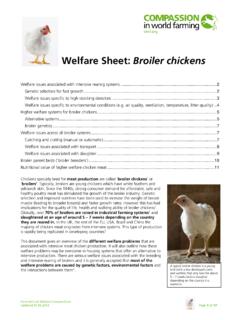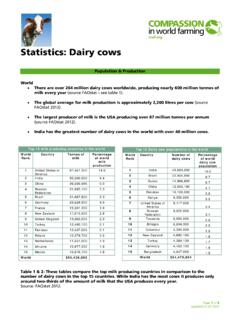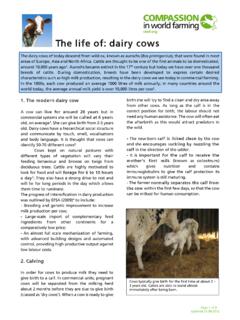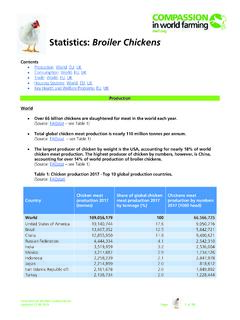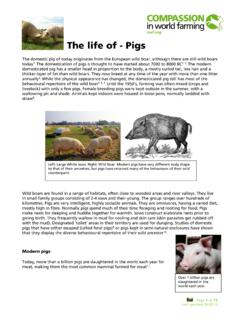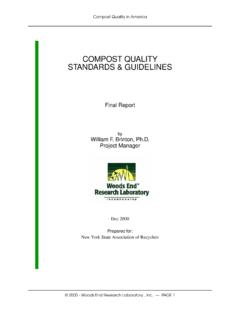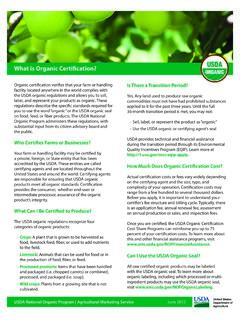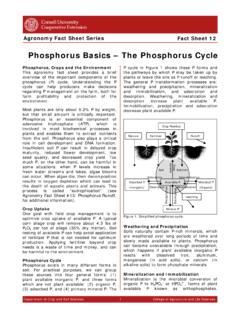Transcription of The Life of: Broiler Chickens
1 farm Animal Welfare Compendium 1 of 9 Updated Page The Life of: Broiler Chickens Chickens reared for meat are called broilers or Broiler Chickens . They originate from the jungle fowl of the Indian Subcontinent. The Broiler industry has grown due to consumer demand for affordable poultry meat. Breeding for production traits and improved nutrition have been used to increase the weight of the breast muscle.
2 Commercial Broiler Chickens are bred to be very fast growing in order to gain weight quickly. In their natural environment, Chickens spend much of their time foraging for food. This means that they are highly motivated to perform species specific behaviours that are typical for Chickens (natural behaviours), such as foraging, pecking, scratching and feather maintenance behaviours like preening and dust-bathing. Trees are used for perching at night to avoid predators. The life of Chickens destined for meat production consists of two distinct phases.
3 They are born in a hatchery and moved to a grow-out farm at 1 day-old. They remain here until they are heavy enough to be slaughtered. This document gives an overview of a typical Broiler chicken s life. The Hatchery The parent birds (breeder birds - see section at the end) used to produce meat Chickens have their eggs removed and placed in an incubator. In the incubator, the eggs are kept under optimum atmosphere conditions and highly regulated temperatures. At 21 days, the chicks are ready to hatch, using their egg tooth to break out of their shell (in a natural situation, the mother would help with this).
4 Chicks are precocial, meaning that immediately after hatching they are relatively mature and can walk around. A chick classified as a day-old chick is up to 72 hours old (this is when the yolk sac in the egg runs out). At present, chicks destined for organic systems are not treated differently until they get to the grow-out farm . Chicks need extra heat and high humidity during the first weeks of life. Newly hatched chicks require ambient temperatures of F to 95 F and relative humidity of 60% to 70%, which can be difficult to achieve at these high Vaccination The modern Broiler reaches slaughter weight within several weeks.
5 This leaves little time to develop a mature immune system. Therefore, Broiler chicks (including organic chicks) are vaccinated against several different diseases. Some infectious pathogens (such as Salmonella) can also be transmitted via the egg (vertical transmission) from the breeder hen to the chick. The breeder hen should therefore also be vaccinated. The most common vaccines used are against Newcastle disease virus, infectious bronchitis virus, coccidiosis, avian pneumovirus, infectious bursal disease, and Marek s ,3 Vaccines are typically delivered via spraying, drinking water, in-ovo, or injection (subcutaneous most common route).
6 Spray vaccination is the preferred and most effective administration technique for respiratory type vaccines. Day-old chicks in a littered barn, with a controlled atmosphere for humidity and temperature control. farm Animal Welfare Compendium 2 of 9 Updated Page Transport of Chicks When Broiler chicks are a day-old, they are transported in transport modules (or chick boxes) from the hatchery to the farm .
7 Chicks travel along a conveyor belt and are dropped into transport boxes or modules. During this process the chicks are immunized with spray and/or subcutaneous vaccinations ( , Marek s disease vaccination injected at hatch if not done in-ovo).2 There are some scientific guidelines dictating the optimal environmental conditions ( , temperature, ventilation) for the transport of day-old ,5 Unlike older birds, newly hatched chicks are unable to regulate their body temperatures so are especially susceptible to thermal stress during transport.
8 Maximum journey times for chicks continues to be debated. Newly hatched chicks are initially sustained by energy and water reserves from the yolk sac for a period of time after hatching, but chick survivability is greatly reduced as the time to first feed and water access ,5 However, new on- farm hatching systems are now available commercially such as the Vencomatic group s X-Treck system, which allows chicks to access feed and water immediately after hatch and avoids the need for transport. Housing Systems for Broiler Chickens Intensive (Industrial) Farming Systems broilers used in intensive systems are from strains that have been bred to be very fast growing in order to gain weight quickly (with typical weight gains of over 50 g).
9 Unlike laying hens (kept for egg production), which live for about a year, broilers only live for several weeks before they are slaughtered. In the EU, the slaughter age can range from 21 to 170 days but is typically around 5 to 7 In the US - the average slaughter age is 47 days at a weight of kg ( lb)7 In the EU the average slaughter age is 42 days at a weight of kg ( )6 Over the last 80 years or so, the slaughter age of a standard fast-growing Broiler has decreased considerably, and the final market weight has also significantly increased (see Figure 1).
10 In comparison, more traditional breeds of meat Chickens can take around 12 weeks to reach slaughter Figure 1. Market age and weight changes since 19257 Globally, over 70% of Broiler Chickens are raised in quite similar indoor intensive (industrial) farming systems9 and only a small proportion are reared in less intensive, higher welfare systems. Keeping Broiler production indoors, without any access to outside areas can help with pest control. In temperate countries, Broiler sheds are closed, climate-controlled ( , fan-ventilated) and have artificial In hotter countries, the sheds are more open with curtain sides so that the Chickens are exposed to daylight and natural ventilation, but have no outside Broiler Chickens are transported twice in their lives, as day-old chicks (pictured) and as adults to the slaughterhouse.
